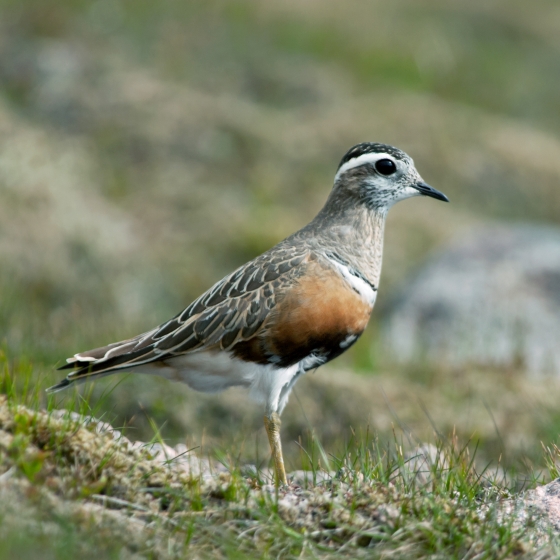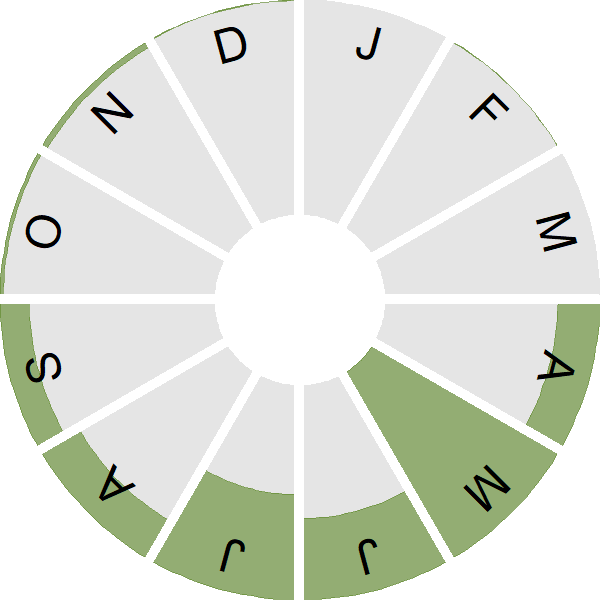Dotterel

Introduction
A pretty wading bird of the highest Scottish mountains, the Dotterel is known for being extremely tame and confiding.
Dotterels are related to plovers, and migrate here in early summer from southern Europe and North Africa to breed amongst the rocky and mossy wastes of Britain's highest mountains. Recent sample surveys estimate that the population has halved in the last 30 years, and their preference for montane habitats makes them sensitive to climate change.
In spring, usually early May, small groups of migrating Dotterel can turn up in bare cereal fields in eastern England. These are known as 'trips', where the birds stop to feed before heading on up to the mountains. Local heritage sometimes records this occurrence with pub and road names featuring 'The Dotterel'.

Key Stats
Identification
Songs and Calls
Song:
Call:
Flight call:
Status and Trends
Conservation Status
Population Change
As a montane species, the Dotterel is difficult to monitor and numbers reported to the RBBP are often only a small fraction of the population. The vast majority of the breeding population is found in the Scottish Highlands, but breeding was confirmed in Cumbria in 2019 and probable breeding occurred in Meirionydd in the same year (Eaton et al. 2021). The Atlas data show a 78% range expansion in terms of the number of 10-km squares occupied since 1968–72 but this is believed to be due to improved observer coverage rather than a genuine change (Balmer et al. 2013). A decline in population was noted between the 1987–88 and 1999 surveys (Whitfield 1999) and a further decline was noted by the time of the 2011 survey, with large declines observed within the core population in the east Highlands (Hayhow et al. 2015).
Distribution
Dotterels breed mainly in the Grampian Mountains, with smaller numbers in the northwest Highlands, with occasional outlying pairs in southwest Scotland and Cumbria.
Occupied 10-km squares in UK
or view it on Bird Atlas Mapstore.
or view it on Bird Atlas Mapstore.
European Distribution Map
Distribution Change
The apparent 78% range expansion since the 1968–72 Breeding Atlas, most evident in northwest Scotland, is probably largely due to improved coverage.
Change in occupied 10-km squares in the UK
or view it on Bird Atlas Mapstore.
or view it on Bird Atlas Mapstore.
Seasonality
Dotterels are summer visitors, most often reported during spring passage and less so when in their montane breeding habitat; rare in winter.
Weekly pattern of occurrence
The graph shows when the species is present in the UK, with taller bars indicating a higher likelihood of encountering the species in appropriate regions and habitats.

Movement
Britain & Ireland movement
Foreign locations of birds ringed or recovered in Britain & Ireland
Dots show the foreign destinations of birds ringed in Britain & Ireland, and the origins of birds ringed overseas that were subsequently recaptured, resighted or found dead in Britain & Ireland. Dot colours indicate the time of year that the species was present at the location.
- Winter (Nov-Feb)
- Spring (Mar-Apr)
- Summer (May-Jul)
- Autumn (Aug-Oct)

European movements
EuroBirdPortal uses birdwatcher's records, such as those logged in BirdTrack to map the flows of birds as they arrive and depart Europe. See maps for this species here.
The Eurasian-African Migration Atlas shows movements of individual birds ringed or recovered in Europe. See maps for this species here.
Biology
Productivity and Nesting
Nesting timing
Egg measurements
Clutch Size
Survival and Longevity
Survival is shown as the proportion of birds surviving from one year to the next and is derived from bird ringing data. It can also be used to estimate how long birds typically live.
View number ringed each year in the Online Ringing Report.
lifespan
Biometrics
Wing length and body weights are from live birds (source).
Ring Size
Classification, names and codes
Classification and Codes
- Order: Charadriiformes
- Family: Charadriidae
- Scientific name: Eudromias morinellus
- Authority: Linnaeus, 1758
- BTO 2-letter code: DO
- BTO 5-letter code: DOTTE
- Euring code number: 4820
Alternate species names
- Catalan: corriol pit-roig
- Czech: kulík hnedý
- Danish: Pomeransfugl
- Dutch: Morinelplevier
- Estonian: roosterind-tüll e. mornel
- Finnish: keräkurmitsa
- French: Pluvier guignard
- Gaelic: Amadan-mòintich
- German: Mornellregenpfeifer
- Hungarian: havasi lile
- Icelandic: Fjalllóa
- Irish: Amadán Móinteach
- Italian: Piviere tortolino
- Latvian: morinela tartinš
- Lithuanian: eurazinis mornelis
- Norwegian: Boltit
- Polish: mornel
- Portuguese: borrelho-ruivo
- Slovak: kulík vrchovský
- Slovenian: dular
- Spanish: Chorlito carambolo
- Swedish: fjällpipare
- Welsh: Hutan y Mynydd
- English folkname(s): Stone Runner
Research
Causes of Change and Solutions
Causes of change
Redistribution of birds to Fennoscandia and problems on the wintering grounds have been suggested as possible causes of the decline in Scotland (Whitfield 2002). It should be noted that Dotterel is an itinerant breeder: individual birds are not necessarily faithful to one breeding site and may move to or from Scandinavia both within and between summers, hence differences between surveys may simply represent differing conditions during the survey years (Whitfield 2002). However, the strength of the decline to 2011 may be evidence that conditions on the Scottish breeding grounds have worsened, with possible drivers including land use changes, nitrogen deposition and the effects of climate change (Hayhow et al. 2015). There are concerns that montane species such as Dotterel will be among the most vulnerable in the UK to the effects of climate change (REF).

